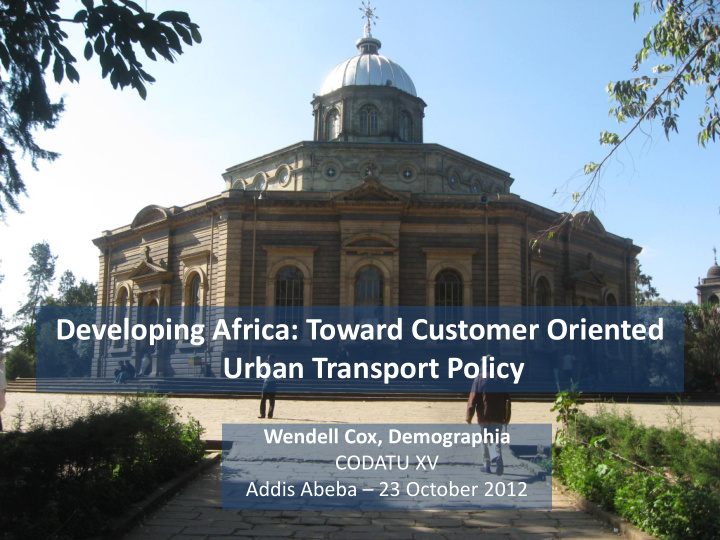



Developing Africa: Toward Customer Oriented Urban Transport Policy Wendell Cox, Demographia CODATU XV Addis Abeba – 23 October 2012
THE SUBJECT --- POLICY, NOT PROJECTS, MODES OR REGULATION --- OBJECTIVES NOT MEANS
THE OBJECTIVE --- ERADICATING POVERTY --- REQUIRES MAXIMIZING ACCESS/MOBILITY
MORE CRITICAL IN DEVELOPING WORLD --- MASS TRANSIT: PRINCIPAL MOBILITY --- MORE DEVELOPED WEST: AUTO
Democratization of Prosperity ASSOCIATION BETWEEN MOBILITY & AFFLUENCE Chicago “Time is Money” Reduced Minority PRUD’HOMME HARTGEN-FIELDS Mobility Improves Mobility Improves Unemployment Productivity Productivity With Cars U. of California U. Of Paris
The Subject: Maximizing Urban Access 650 BC TO 2000 • Urban access can be measured from the urban area level to between small zones within the urban area. Urban access may be defined as follows: • Urban access is the percentage of metropolitan area employment that can be reached (door-to- door) by the urban transport system in a specified period of time (such as 30 minutes).
Economics: A History of Poverty CANNOT TAKE AFFLUENCE FOR GRANTED Dhaka 7
Highest National GDPs: 1500-2000 650 BC TO PRESENT $45 000 GDP/Capita: Richest Nation: 2000$ $40 000 PRINCIPAL Mass Walking Auto $35 000 MODE Transit $30 000 $25 000 From Maddison $20 000 (OECD) $15 000 $10 000 $5 000 $0 1500 1550 1600 1650 1700 1750 1800 1850 1900 1950 2000 Figure 8
Rio +20 Declaration ERADICATING POVERTY: INDISPENSABLE REQUIREMENT Eradicating poverty is the greatest global challenge facing the world today and an indispensable requirement for sustainable development.
World’s Largest Cities (Urban Areas) 650 BC TO 2000 35 From 30 Chandler Population (Millions) 25 20 15 10 5 0 650BC 400BC 200BC 100AD 500 900 1000 1100 1200 1300 1400 1500 1600 1700 1800 1850 1900 1950 2000 Year: (Irregular Scale) Figure 10
Why Cities Grow (Their Purpose) ALAIN BERTUAD, FORMER WORLD BANK PLANNER – The raison d’être of large cities is the increasing return to scale inherent to large labor markets. The cities’ economic efficiency requires, therefore, avoiding any spatial fragmentation of labor markets.
As Cities Grow They Become Less Dense ADDIS ABEBA 1972-2010
Average Population Densities: 2012 URBAN AREAS OVER 2.5 MILLION: SUB-SAHARAN AFRICA Less Developed World More Developed World India Developing Africa China Japan Calculated from data in Demographia World Western Europe Urban Areas Canada 0 3 000 6 000 9 000 12 000 15 000 Average Population per Square Kilometer Figure 16
Coming to Terms with Global Urban Expansion
African Cities are Too Large for Walking ALREADY TOO SPATIALLY LARGE • . The cities of developing Africa may have long since become too spatially large for walking to suffice as a principal mode of access without hobbling economic growth and ingraining high levels of poverty.
Autos in All Western Europe & North America MAJORITY OF MOTORIZED TRAVEL IS AUTO IN ALL CITIES Example PORTLAND Transit +Cycle+Walk Market Share Down 9% 1980-2011
CAR & 2-WHEELER Provides access to within walking distance of all points in the urban area
STRENGTHS AND WEAKNESSES OF MASS TRANSIT For most trips mass transit is not available or feasible
YOU CANNOT EXPECT PEOPLE TO MAKE IRRATIONAL CHOICES
Capability of Transit: 45 Minute Job Access USA METROPOLITAN AREAS OVER 2,000,000: 2008 Atlanta Baltimore Boston Chicago Accessible by Transit Cincinnati Not Accessible by Transit Cleveland Dallas-Fort Worth Denver Detroit Houston Kansas City Los Angeles Miami Minneapolis-St. Paul New York Average Orlando Philadelphia Phoenix Transit Job Pittsburgh Portland Access: 5.6% Riverside-San Bernardino Sacramento (NYC: 9.8%) San Antonio San Diego San Francisco Seattle St. Louis Tampa-St. Petersburg Washington 0% 10% 20% 30% 40% 50% 60% 70% 80% 90% 100%
Paris Suburbs: Cars Provide Quicker Travel FROM MAJOR SUBURBAN RAIL STATIONS: 1 HR TO JOBS Suburbs 83% of Population Jobs Accessible 16% Not 59% Accessible Not Accessible 84% Transit Auto Jobs Accessible 41%
Reforming the Informal Sector TRANSANTIAGO EXAMPLE
Mass Transit Service Densities MILLENNIUM CITIES DATABASE: 1995 Manila Hong Kong Dakar Singapore Zurich Vienna Tokyo Paris Calculated from data in Toronto Millennium Cities Database New York (UITP) Vancouver Denver 0 1 2 3 4 5 6 7 8 9 Figure 28 Average Vehicle Kilometers per Urban Square Kilometer
World’s Most Dense Service MANILA: PRINCIPALLY JEEPNEYS DAKAR High Density Service Profile 29
2-Wheelers & Personal Mobility HO CHI MINH CITY
Dapice, Gomez-Ibanez, & Thanh ON HO CHI MINH CITY & MOTORCYCLES • ...the motorcycle offers many of the conveniences of a private automobile, such as on-demand, door-to-door service, and the ability to make intermediate stops and carry packages and extra passengers. Many Vietnamese have more than one job and children to drop off and pick up at school, and thus value the flexibility of a motorcycle.
Suzhou
Policies for Urban Access BASED UPON PRUD’HOMME/LEE & OTHERS • Employment (Enterprise) access: The employee access indicator would estimate the number of jobs in an urban area that can be reached by workers from specific zones and overall within a fixed period (such as 30 minutes). • Employee (Worker) access: The work force access indicator would estimate the number of potential employees in an urban area that could reach employment locations in specific zones and overall within a fixed period (such as 30 minutes). • Cost per reduced delay hour (Texas Governor’s Business Council)
FOCUSING ON OBJECTIVES NOT MEANS
Recommend
More recommend